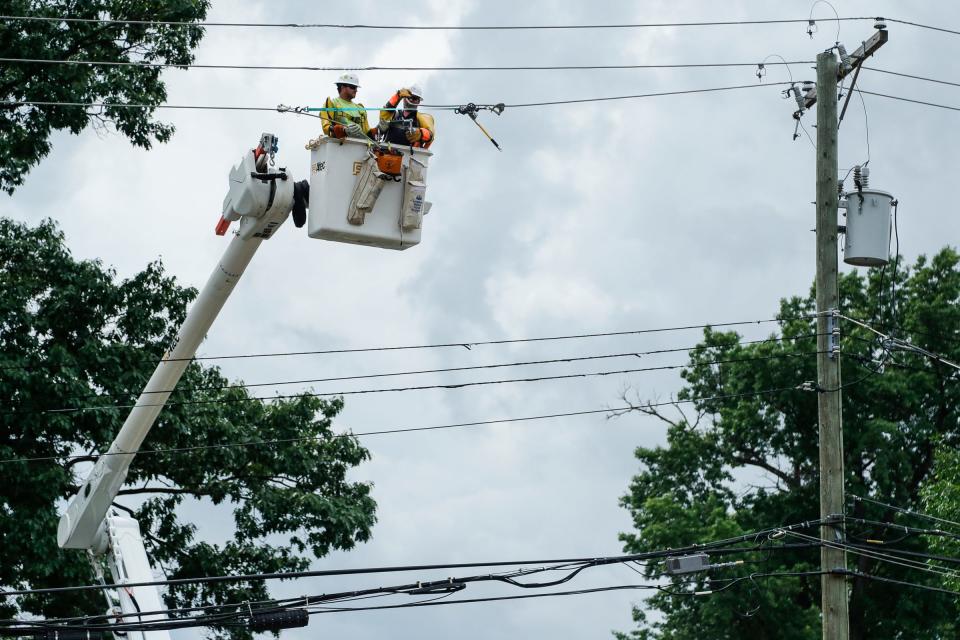What DTE is doing about reducing power outages
Steve Danner had just brought his 88-year-old mother back to his Redford home to recover from surgery in late February when a severe ice storm knocked out power for him, and hundreds of thousands of others, in Michigan.
"It was horrible," said Danner, a DTE customer. "... I was out probably four-and-a-half, five days. It was tormenting to say the least."
The storm, which hit southeast Michigan on Feb. 22, caused widespread outages, taking away power from thousands like Danner in the middle of the state's harsh winter. About 700,000 customers between Detroit-based DTE Energy and Jackson-based Consumers Energy lost electricity.
With adverse weather events becoming a more frequent issue for Michigan, officials recognize that hardening the electric grid will be key to ensuring the lights — and the fridge, and the heat, and the internet — stay on more consistently.
"The realization for us is that the storms are no longer historic. They might have been 10 or 15 years ago, but now they're becoming our new normal where every two or three years we're going to get hit with these very significant and severe weather events," said DTE Energy CEO Jerry Norcia, during a recent sitdown with the Free Press.
Danner said his mother recovered, but described an "inconvenient" experience trying to find a generator, then a hotel room to keep her warm. While his power was out, frozen and refrigerated food spoiled. He bought a lithium-ion battery, but it didn't have the juice to run his fridge and a heater to keep his house warm at the same time.
Danner is unsure whether he received the $35 credit offered by the utility to customers who experienced long outages. He said he was frustrated with the slow response from DTE, having not heard from the company in the first two days of the outage.
"It was probably the worst experience that I had with DTE in my 30-plus years of paying for it as a customer," he said.
Lawmakers in Michigan want to hear from residents about their experiences with power outages — House Energy, Communications and Technology Chair Rep. Helena Scott, D-Detroit, announced the creation of the Energy Reliability, Resilience and Accountability Task Force on Thursday. The task force will hold a statewide listening tour this summer, with the end goal of introducing new measures to increase the reliability of Michigan's electric grid.
During a March committee hearing, DTE Electric CEO Trevor Lauer said he sympathized with customers who lost food, medicine and even pets during the outages caused by the ice storm. Here is what DTE says it's doing to prevent outages in the future, particularly as the company acknowledges adverse weather events in Michigan are here to stay.
More: 5 things we learned from our sit-down with DTE Energy CEO Jerry Norcia
More: DTE and Consumers report lower Q1 earnings, blame storms and reduced electric use

What DTE is doing to prevent power outages
Norcia said the company has invested over $5 billion in the last five years in improving its electrical grid. This includes repairing and replacing outdated power lines and poles, trimming trees with branches that hang over utility lines, upgrading the substations used to transfer electricity to homes and businesses, moving more parts of its electrical system underground, and automating parts of its electric system where it can.
DTE says nearly 70% of its outages are caused by fallen tree branches. In 2021 and 2022, DTE spent a combined $420 million on cutting down long branches which hang over and threaten electrical wires in the event of a storm, according to Lauer's testimony in March. Data from the Michigan Public Service Commission indicates the frequency of outages was reduced by 74% on DTE's grid in areas where tree trimming took place, and the length of those outages also decreased by 67%.
Modernizing DTE's electric grid is also an ongoing process, officials say. In a 2021 letter penned to customers, Lauer and Norcia said that while much of the electric grid was modernized during the 20th century, parts of the grid that are more than 90 years old remained in operation.
DTE wants to replace circuits and put some underground. Norcia said a third of the company's infrastructure is underground. The rest is up in the air and parts of it are outdated, meaning it was built in the first half of the last century and of a lower voltage. That older infrastructure is found in cities like Detroit, Ann Arbor, Grosse Pointe, Birmingham, Royal Oak and Dearborn. DTE plans to replace about 16,000 miles of this circuit that causes the most trouble day-to-day and during storms.
Automating the grid involves the installation of devices called smart meters and smart grid sensors. The technologies allow DTE to identify and isolate power outages more quickly, as well as restore power faster to areas where they are in place.
Adrienne Roberts and Nushrat Rahman contributed to this report.
Contact Arpan Lobo: alobo@freepress.com. Follow him on Twitter @arpanlobo.
This article originally appeared on Detroit Free Press: DTE's plan to reduce power outages: What to know

